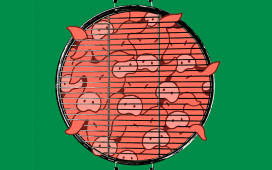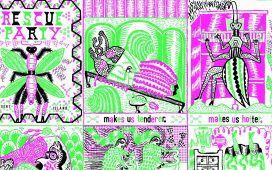Contrary to popular conception, Thanksgiving is a holiday not of turkey and side dishes and pie but of lubrication. It would be enough on its own to have a dozen people over for dinner; it would be enough on its own to plan and execute a multipart meal built around a disorientingly massive bird; it would be enough on its own to spend half a day or more in intimate social proximity to one’s family, natal or chosen, plus wild-card oddments of new girlfriends and old neighbors. Any one of these elements is sufficient to level up a person’s baseline anxiety. All of them, all at once, mean one thing: make yourself a drink.
For me, on Thanksgiving, that drink is always a Boulevardier. Cocktail historians might blanch at describing it as a variation on a Negroni, but, at least structurally speaking, that’s exactly what it is. You take one part Campari, one part vermouth, and then—and here’s where the magic happens—you forgo the gin, whose piney haze gives a Negroni its crisp and wintry backbone, and instead introduce the warm, spicy roundness of whiskey. You can use any sort, from a plastic-bottle bourbon to a palate-blasting peated Scotch. I’m partial to making it with an intense rye, such as Willett or New Southern Revival.
The Boulevardier is one of those intensely well-documented cocktails, with a pedigree that runs longer than that of some racehorses. Erskine Gwynne, a wealthy young American who fluttered about Paris between the World Wars, was probably not the first person to mix whiskey with Campari and vermouth, but he was the first to have the recipe written down with his name next to it. Gwynne, a scion of the Vanderbilt family and brother to the notorious socialite Kiki Preston, was a bon vivant with a literary bent. He ran with a pack of slender, moneyed partygoers, swanning from restaurant to night club to onion-soup breakfast, in a Franco-Wodehousian haze of cash and champagne. To chronicle their wild times, he started a magazine called The Boulevardier. It ran for five years and did not leave much of a legacy, other than commissioning a few illustrations by Alexander Calder and—par for the course for vanity magazines run by Americans in Europe—once or twice publishing Hemingway. Gwynne’s claim to the Boulevardier cocktail was cemented in “Barflies and Cocktails,” a 1927 collection of drink recipes by Harry MacElhone, the legendary owner of Harry’s New York Bar, in Paris, which, in a gossipy appendix, by Arthur Moss, lists the favored drinks of various notables. “The variety of tastes exhibited by any group of Men-About-Town has driven many a good bartender to drink,” Moss writes. “Not only do they clamor for every possible liquid combination; they even invent their own.”
Moss’s litany of drinks, sourced from boxers, aviators, cartoonists, and other livers of the high life, frequently runs to the joyously absurd. The ambitious home bartender can attempt a “Vowel Cocktail,” which calls for Angostura bitters, Eckau kümmel, Italian vermouth, orange juice, and Usher’s whiskey. Or one could perhaps rustle up a “Gringo Killer,” made up of one part pulque, two parts tequila, one part brandy, and a dash of “liquid marijuana,” a concoction “guaranteed to put a Tarantula to sleep for a year.” Among these dazzlers, Gwynne’s Boulevardier is notable for its simplicity. His version is three ingredients in three parts: “⅓ Campari, ⅓ Italian vermouth, ⅓ Bourbon whisky.” My preferred rendition, made with rye, is something that sticklers will note is more properly called an Old Pal, a cocktail that was also first coined in Moss’s rundown, attributed to the sportswriter Sparrow Robertson: “⅓ Canadian Club, ⅓ Eyetalian vermouth, and ⅓ Campari.” Although I’m a big fan of fussy categories, this seems like the sort of hairsplitting that would have mattered to a bartender in the nineteen-twenties but not so much to, for example, someone like me, on Thanksgiving afternoon, catching ten seconds of alone time in a corner near the bottles.
Like many books of its type and era, “Barflies and Cocktails” is peppered with advertisements, including a full-page notice for The Boulevardier, on the second-to-last page. It proposes an impish recipe of its own, with the ingredients running in a vertical list and their initial letters emphasized: “Bacardi, Orangeade, Uranite, Lemonade, Evian, Vodka, Absinthe, Rhum, Dubonnet, Ink, Egg nogg, Rye. Mix all these before subscribing to THE BOULEVARDIER, the magazine that is read before, between and after cocktails. THAT TIRED FEELING disappears after you have squandered the price of a subscription to THE BOULEVARDIER.”
The Boulevardier magazine has drifted out of the historical archive, and the Boulevardier drink didn’t make enough of a splash to earn so much as a passing mention in Gwynne’s obituary. The headline—“Erskine Gwynne, 49, Wrote Book About Paris”—references his 1936 novel, “Paris Pandemonium,” whose pre-publication blurbs vowed that the city’s “loosely moraled married women and their gigolos will be faithfully etched.” Alas, it was panned by the Times for delivering “only rudimentary devilishness.” But Gwynne and his favorite cocktail have had something of a resurgence in recent years. Nearing its centenary, the Boulevardier feels like a strikingly modern drink. It’s been shepherded back into the spotlight thanks to influential fans, such as the writer Robert Simonson and the bartender and writer Toby Cecchini. “It tastes the way illustrations in a 100-year-old book look,” Alex Delany wrote in Bon Appétit, a few years ago. At the same time, he continued, “drinking one feels like floating around in a lava lamp filled with sweet cherries, bittersweet orange peels, and dried stone fruit.”
It really is all that—it’s heady and deep, a woodsy cloud with a bitter edge, the flavor transforming on the tongue into something spicy and bright. It’s also strong as hell; its only nonalcoholic components are ice, a twist, and a glass. Since Gwynne’s day, the straightforward one-one-one ratio has evolved into two parts whiskey to one part each of Campari and vermouth, which more evenly balances out Campari’s sticky sharpness and gives the whiskey more room to roll around. Best of all, at this time of year, when the corn bread is burning, and the kitchen is a sweatbox, and the cat is likely lost under a pile of coats on the bed, and what you’re most thankful for is a cocktail that’s nice and easy and right the hell now, all you need to do is find whiskey, Campari, and vermouth—all of which any decent Thanksgiving bar ought to have—and a Boulevardier is just moments away. Pour it over ice, take a sip, and, oh, just as promised, that tired feeling disappears.
Boulevardier
Ingredients
2 oz. bourbon or rye
1 oz. Campari
1 oz. sweet vermouth, such as Carpano Antica
A strip of lemon or orange zest, for garnish
Instructions
Fill a mixing glass with ice. Pour ingredients over ice and stir together. Strain into a martini glass or coupe, or into a rocks glass with ice. Twist the citrus zest over the drink, then drop it in.
To batch Boulevardiers for a crowd, increase the quantities proportionally and mix the drink in a large ice-filled pitcher, rather than in a mixing glass. Serve immediately after mixing. Don’t make this ahead of time; the flavors soften and blur as they rest.








